Is It Safe To Use A Wood Stove In An RV?
Is it safe to use a wood stove in an RV? The easy answer is yes, but only under one non-negotiable condition: it must be the proper size, and be installed correctly with all safety precautions in place.
We know that travel trailers, motor homes, and DIY RVs like skoolies are made of very flammable material. They can burn to the ground in minutes. Adding a steel box in which you purposefully ignite a fire seems a bit foolhardy. However, if installed according to manufacturer’s specifications with careful adherence to recommended clearances, the risk is minimized and the outcome can be quite nice.
Pros of Having a Wood Burning Stove in an RV
- Provides a lot of warmth with practically free fuel.
- Helps dehumidify the RV.
- Provides a secondary cooking surface besides your RV stove.
- Does not require electricity.
Cons of Having a Wood Burning Stove in an RV
- High winds may back-draft ash and smoke into the RV.
- It’s not safe to drive while a fire is burning.
- Depending on the height of your rig, you might need to remove the smoke stack for travel.
- A wood stove and its fuel takes up space.
- While the wood stove might be lightweight, the hearth and/or safety shields might be heavy.
- There may be an impact on your insurance coverage. Check it out before installing.
- The warmth may stop your regular furnace from running. If your furnace doesn’t heat the underbelly, water pipes might freeze.
One of the Most Popular Tiny Wood Stoves

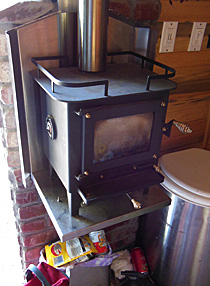
One of the most popular and tiniest wood stoves is the Cub Cubic Mini. It measures only 11″ (Wide) x 12″ (High) x 10.5″ (Depth). Because of the size the fuel can only be 5.75″ long. It can produce between 6000 BTU – 14, 000 BTU.
The Cub requires a horizontal clearance of 20″ in all directions without shielding and a vertical clearance of 30″. Clearances are reduced to just 3″ when using proper mounting and shielding.
The stove needs a complete flue system comprising of 3″ flue pipe, 5″ insulated pipe and exit kit (not included).
Cubic Mini has a slightly larger version called the Grizzly Cubic Mini that measures 13″ (Wide) x 15″ (High) x 12″ (Depth). The ideal fuel can be 6.75″ long. It can emit between 8000 – 18000 BTU.
You can get them with or without the beautiful brass trim like the one shown in the image to the left. I found this one installed in a Converted Sprinter van using the stainless steel wall mount.
Mounted in a Campulance
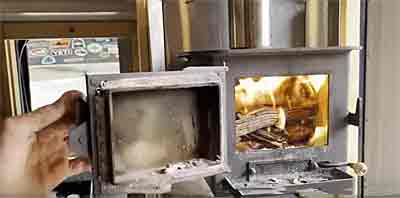
Here’s a beautiful ambulance to camper conversion with a Cubic Mini wood stove mounted by the side door.
Click on the image to see more about this campulance. Just below the photo is a nice storage area for the wood stove fuel. The owner chooses to use densified Pres-to-logs which burn a long time and help keep your fuel storage area tidy.
Cubic Cool Accessories
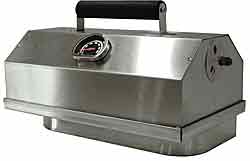
Cubic has a very nice mini roaster that sits on the top of their wood stove. The temperature can be accurately controlled so your meals turn out perfectly.
Another cool accessory is the clip on water tank. It will supply you with just over 2.5 liters of hot water in about 30 minutes.
Wood Stove Safety is a Matter of Right Sizing
“Traditional BTU calculators tend to overestimate the BTU needs of your space. Having a larger than needed heater makes sense with a traditional heating system, but if a wood stove is too large for a space, you won’t be able to burn the stove cleanly without overheating your living space. So many people, even in traditional houses, end up with stoves that are simply too large to be useful!
This calculator is specifically designed to size small wood stoves for tiny spaces. If you want to use a wood stove to heat your tiny home, bus, RV, yurt, shed, van, or other tiny structure, this stove selector is the best place to start.”* Tiny Wood Stove’s BTU calculator
The Tiny Wood Stoves website has a great section about size, installation, maintenance, and operation of tiny wood stoves in RVs.

The Tiny Wood Stove company offers a free six page e-book with crucial information I found fascinating. Download it here.
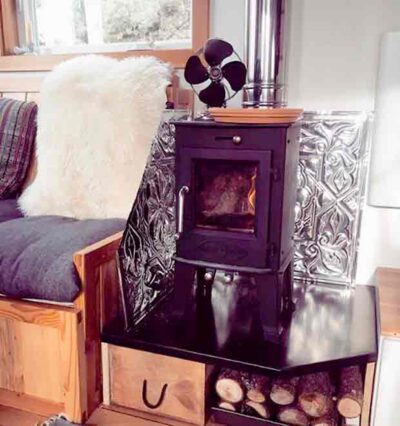
The Tiny Wood Stove company sells three sizes of their awesome wood stoves, the Dwarf 3,4, and 5. The Dwarf 3k is perfect for camper vans and most other small RV’s. A Dwarf 4k (shown here) is a good size for larger RV’s. The Dwarf 5kW (shown above) would be the best choice for a 40′ skoolie or tiny house.
These Tiny Wood Stoves Have Some Important Features
“If your stove is getting its fresh air from inside your home, that air will need to be replaced by sucking cold outdoor air in through leaks around doors and windows. And if your home is relatively airtight, you’ll find that you need to open a window to provide enough air for your fire to burn well.”
Outside Air Vent
One of the most important features of a Dwarf tiny wood stove is the outside air intake vent. “Wood stoves need a sufficient fresh air supply to function, whether that air comes from inside your home or directly into the firebox from outside. Installing a pipe directly from outside into your wood stove will reduce cold drafts and keep your fire burning efficiently.”
You Can Install The Flue From the Back or The Top
Installing the flue from the back gives you more space on top for cooking. The Dwarf 5K also has a neat optional baking oven that can attach to the top. See it in the widget section of this page.
Dwarf Heat Shield
The Dwarf Heat Shield kit reduces clearances by 50% from the back and sides of your Dwarf Stove. This easy-to-install kit attaches directly to the accessory mounting points on the wood stove. It does not shield the flue pipe, however. Read more details on their website.
Clearances: 16” sides, 18” rear, 36″ top to ceiling. You can reduce required clearances by up to 2/3 with a properly designed heat shield.
How to Construct Air-Cooled Heat Shields
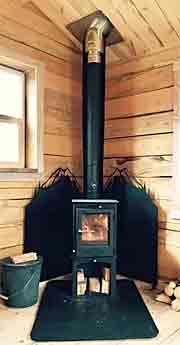
The Tiny Wood Stove website has good instructions on building a safe wood stove surround. If you take a few minutes to think about it, you might design something that’s really cute as well as useful. It can be safely done.
Read the instructions carefully. Keep in mind the stove pipe needs to be shielded as well.
Most people use a cement board then some nice tile. The important thing is to make sure there is a 1″ air gap behind the non flammable material so air can circulate. There needs to an air gap at the bottom so air can enter, and an air gap at the top so the air can exit. Use heat shield spacers to hold the cement board away from the wall. While tile and cement board are not flammable they can transmit the heat to the materials behind them if an air gap is not provided.
Corrugated metal can be used as well, as long as you have the 1″ air gap behind it.
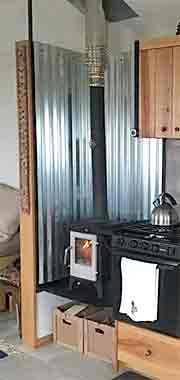
Here’s the best YouTube® video I could find on the subject.
This YouTube® video shows the Cubic Mini being installed in a tiny cabin.
Here’s a video installing the Cubic, Grizzly in a DIY travel trailer.
A guy showing his install is questioning the logic of it in this YouTube® video.
For more information on tiny wood stoves visit this page of the Tiny Life Consulting website: Wood Stoves for Tiny Abodes
Additional pages of our website you’ll be interested in
Best Way to Prepare Firewood for a Tiny Wood Stove


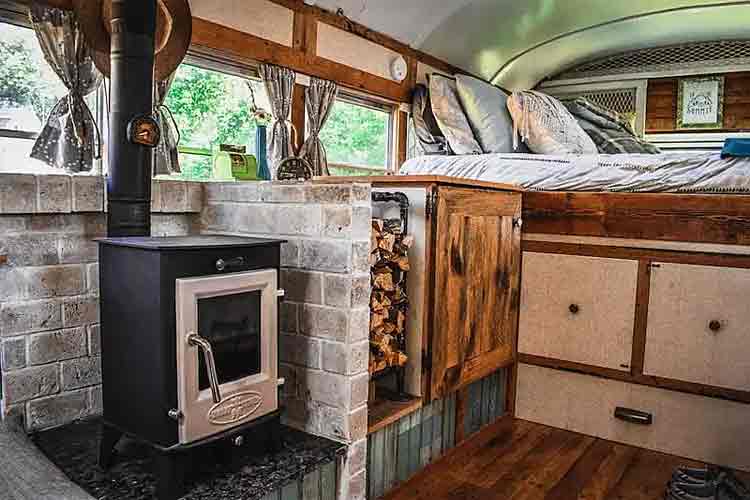



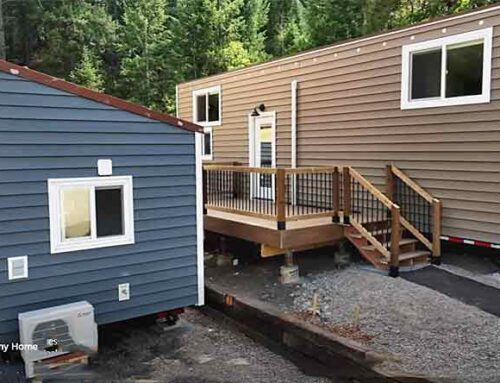
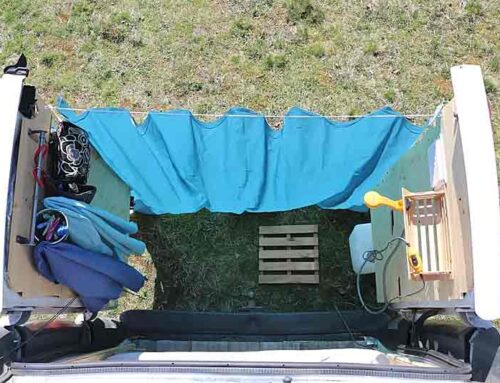
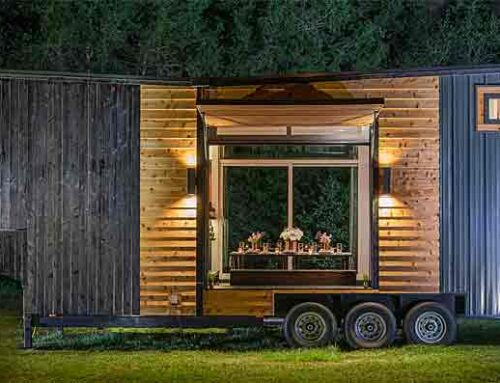
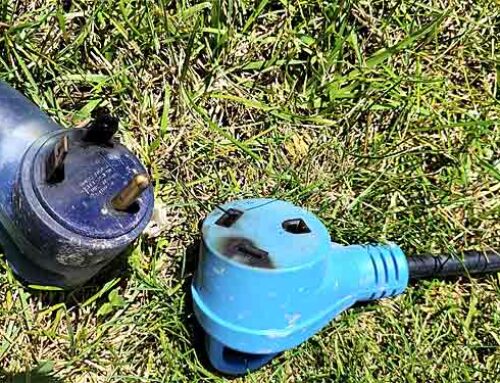
Leave A Comment